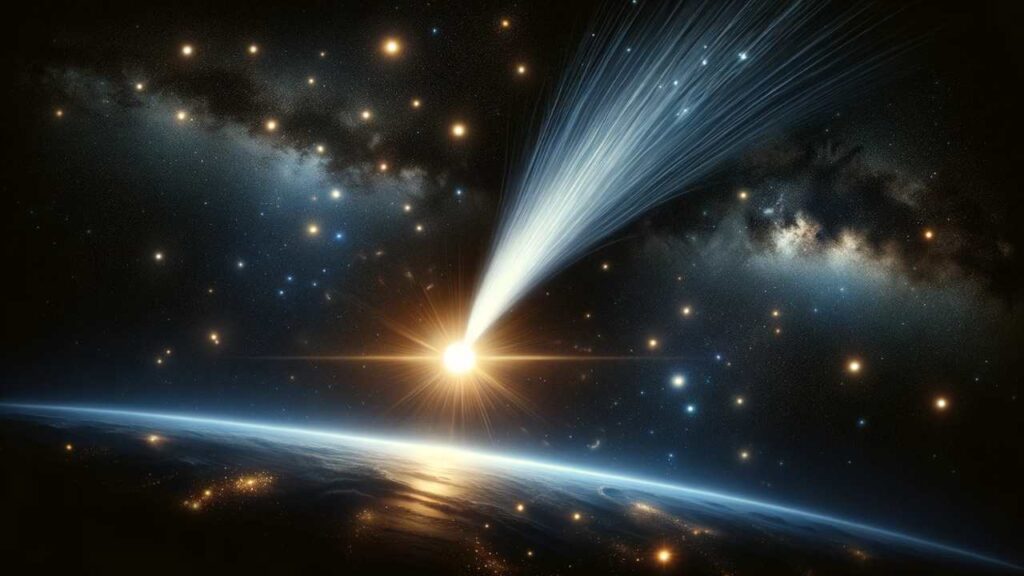“Discover the marvel of Comet 12P/Pons-Brooks in 2024, a celestial phenomenon gracing our skies. Learn about its journey, historical significance, and how you can witness this rare event. Ideal for astronomers and sky enthusiasts alike, delve into the details of its orbit, visibility, and the best times for observation.”
In 2024, Comet 12P/Pons-Brooks is set to captivate astronomers and skywatchers with its rare and spectacular journey through the solar system. This article delves into the intriguing aspects of Comet Pons-Brooks, from its historical significance and orbital dynamics to observation tips for witnessing this celestial marvel.

Comet 12P/Pons-Brooks, often dubbed the “Devil Comet” due to its striking appearance, embarks on its celestial voyage with a 71-year elliptical orbit that takes it from the distant reaches near Neptune to the vicinity of Venus. This journey positions it as a potential spectacle in the night sky, visible to the naked eye under the right conditions.
The comet’s nucleus, estimated at 18 miles in diameter, is a relic from the early solar system, offering a glimpse into the cosmic past. Historical records trace its sightings back to the early 19th century, with the first documented discovery by Jean-Louis Pons. The comet is notable for its dynamic behavior, including dramatic gas outbursts that enhance its visibility and sometimes result in a split tail phenomenon.
As Comet Pons-Brooks approaches the inner solar system, it undergoes significant physical transformations. The Sun’s heat causes sublimation of icy compounds on the comet’s surface, leading to the ejection of gas and dust that forms its characteristic tail. This process, often unpredictable, can lead to sudden increases in brightness and visibility, known as outbursts.
In the spring of 2024, the comet is expected to become a prominent feature in the night sky, particularly in late March and early April. During this period, the comet will traverse through constellations like Andromeda, Pisces, and Aries, heading towards Taurus where its perihelion (closest approach to the Sun) will occur on April 21, 2024. At this point, it is anticipated to reach a brightness of magnitude 3.0, making it an accessible object for naked-eye observation.
For amateur astronomers and enthusiasts, key dates for observing Comet Pons-Brooks include encounters with celestial landmarks such as the thin lunar crescent on April 10 and a close approach to Jupiter and Uranus on April 12. The total solar eclipse on April 8 presents a unique opportunity to view the comet in a dimmed sky, although its exact brightness during the eclipse is uncertain.
Observation tips for Comet Pons-Brooks emphasize the importance of dark, clear skies free from light pollution. Optimal viewing times are during the early evening or pre-dawn hours, with the comet located in the western to northwestern part of the sky. While visible to the naked eye, binoculars or a small telescope can enhance the viewing experience, revealing finer details like the comet’s tail and coma.
The significance of Comet Pons-Brooks extends beyond its immediate spectacle. Its return offers scientists and astronomers a chance to study a classical comet with a well-documented history, contributing to our understanding of cometary dynamics, solar system evolution, and the broader cosmic environment.
Post-perihelion, Comet Pons-Brooks will journey towards the constellation Orion, gradually fading from view in the Northern Hemisphere but becoming a spectacle for observers in the Southern Hemisphere. Despite its dimming brightness, the comet will remain an object of interest for astrophotographers and serious observers, equipped with more powerful observational tools.
In conclusion, Comet 12P/Pons-Brooks’ 2024 apparition presents a unique celestial event, bridging historical astronomical observations with contemporary scientific inquiry. Its appearance offers a rare opportunity for both professional astronomers and amateur skywatchers to witness and study a dynamic and historic comet. As the comet weaves through the celestial tapestry, it continues to fascinate and inspire, reminding us of the wonders of our universe and the ongoing quest to understand it.
